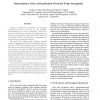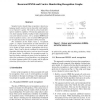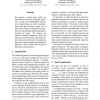163 search results - page 15 / 33 » Use of Lexicon Density in Evaluating Word Recognizers |
ICPR
2004
IEEE
14 years 8 months ago
2004
IEEE
Analysis of allographs (characters) and allograph combinations (words) is the key for the identification/verification of a writer's handwriting. While allographs are usually ...
ICDAR
2009
IEEE
13 years 5 months ago
2009
IEEE
Standard cursive handwriting recognition is based on a language model, mostly a lexicon of possible word hypotheses or character n-grams. The result is a list of word alternatives...
TASLP
2010
13 years 2 months ago
2010
To solve the knowledge bottleneck problem, active learning has been widely used for its ability to automatically select the most informative unlabeled examples for human annotation...
ACL
2009
13 years 5 months ago
2009
We present a global joint model for lemmatization and part-of-speech prediction. Using only morphological lexicons and unlabeled data, we learn a partiallysupervised part-of-speec...
LREC
2010
13 years 9 months ago
2010
Conventional methods for disambiguation problems have been using statistical methods with co-occurrence of words in their contexts. It seems that human-beings assign appropriate w...



